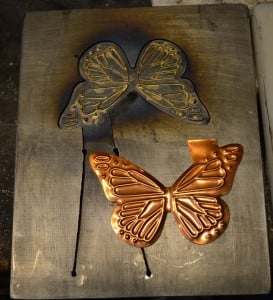 The BF design is by Lisa M. Fida of Timber Bay Home and Garden http://www.timberbayhg.com/ and I have done several other similar jobs for them . This BF is 3” wide by 2” tall , made from 26 ga. copper. The die works as a one-step cutting and embossing set , where the pancake die has wire designs soldered to it’s face, and a bottom base plate female mold made of ½” nylon .
The BF design is by Lisa M. Fida of Timber Bay Home and Garden http://www.timberbayhg.com/ and I have done several other similar jobs for them . This BF is 3” wide by 2” tall , made from 26 ga. copper. The die works as a one-step cutting and embossing set , where the pancake die has wire designs soldered to it’s face, and a bottom base plate female mold made of ½” nylon .
To begin, I chose to use 5/64” tool steel for the die , which is two thicknesses (3/64” would be sufficient to cut a flat BF that size) up from what’s needed for 26 ga. . This is to give the die more strength and rigidity , and to help it stay as flat as possible (without resorting to using even thicker steel). So, the first phase was to cut and heat treat the pancake die , then use a piece cut from it as a template/guide to layout the next phase : making the wire designs for embossing the wings.
In all previous similar die projects, the designs were less complex , and my approach was to fabricate the wires to shape in separate pieces , then arrange them all properly onto the die face while fluxing and heating the whole affair right before soldering . Usually I get everything in place and carefully, gradually flux it up with white paste flux , and heat things slowly so the wires don’t move around much. Sometimes I tin the die face first , but usually I get things consolidated in place in molten flux , and then apply super-easy wire silver solder .
I procrastinated doing the wire designs for a couple of weeks because I knew it was going to be a difficult job , and when I finally forced myself to tackle it , I took a serious look at the artwork of the wings and literally thought “what have I gotten myself into now !? “ . Not that I didn’t think I could do it; just that I knew I wasn’t going to make out very well with the price estimate I’d given . After a few minutes of staring at the design with what must have been a dumb look on my face , I came up with a plan .
The pictureat right is of how that plan looked in action : soldering 4 modules together first . the artwork had the wing designs broken up into four separate sections , so I figured my best (and only good) choice was to build four separate sections together first , and then arrange those on the die face for a much easier soldering of design components to die . I took the flat piece cut from the die and placed it on a foamed ceramic board , then traced around it with a red pen, then marked four corner points to locate each of the four modules . I fabricated the basic wire pieces in the usual manner , then took wires from one module at a time and arranged them on the soldering board , and used medium solder to make the modules. The wire is 24 ga. nickel silver round wire . The pic shows the two top wing-half modules already soldered , and the bottom two in the process of soldering .
—————————————————————————————————–
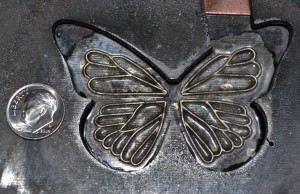
The picture with a dime next to the BF shows the die just after soldering the four wire design modules to the die face . The flux is still on and the strip of copper used to prop the die open for soldering is visible. My soldering setup for this is a simple as can be; I place the butt end of the die in an arbor press which has platens that are heavy enough to function as a clamp, holding the die out horizontally. I use an oxy-acetylene welding torch for most of these operations, with a reducing flame . The die is propped open to allow the heat to be concentrated on the design area instead of the outer body of the die. This is to minimize the possibility for the body of the die to deform, distort , warp, or shift out of alignment. With a relatively simple design shape such as this butterfly , the BF itself is not likely to change shape at all , but what can happen is that it will warp out of flatness if heated only from the back . Too much such warping could be very bad for an embossing die like this . It could be very difficult to get the nylon base block to conform correctly to the die’s curvature .
My approach is to heat mostly from the back slowly to allow the flux to settle down and minimize oxidation of the nickel and steel areas to be soldered . Once the flux is molten and almost ready for soldering , I heat from the top so that the wire solder will melt quickly and not too much more time is spent with the die being hot . A few minutes at the flow temperature of 56% -silver solder is not enough to take that much of the hardness out of the pancake die , but I am careful not to heat things past where they need to be , or for very long . I do not make my dies very hard compared to conventional die sets , and a die like this doesn’t need to be very hard in order to cut 26 ga. soft copper for a very long time. Once the soldering is complete , I anneal the hinge of the die at the area just below the design (to leave it more flexible) and then the base of the hinge , to leave the die in a semi-open position . A barely-visible dull red color is a good indicator of heat for positioning the hinge .
The next picture shows the die cleaned up after soldering on the main wires and the shot after that is of the die with all of the detail designs soldered on , and the die realigned after soldering . The only corrections that were needed were standard hinge-shifting that happens to almost every die when I torch the hinge as already described. A few bangs with a big ballpein hammer is all it takes .
So, on to the next phase : creating the female embossing mold , but first , bit about why such a mold/base is desirable and/or needed in the first place . Basically it’s to make the embossing happen at lower pressure –therefore faster and easier- than is possible pressing into either a urethane pad or a flat nylon (or other soft plastic) block . I’ve made lots of similar dies but with less-complicated embossed designs, and many of those work fine pressing into a hard urethane pad . The detail isn’t as crisp , and it’s not the best thing for dies to press them into anything that gives like urethane does under pressure . I have cracked dies with this method, and one should never , ever use urethane with pancake die that’s meant for cutting flat parts . Some of these cut-and-emboss dies push down into the urethane so much that it prevents the die from closing all the way , which means that the part doesn’t get cut all the way out. Some designs take more pressure than is practical , or available , to fully emboss , so even though it’s a lot more work to make the conforming mold, it’s often necessary, and definitely worth it , because of results and time save in production . This particular BF might form well pressing in hard urethane at 40 or 50 tons, but with it’s solid nylon base , with the negative designs melted in, it only takes about 15 tons .
One option for melting the design into the nylon block would’ve been to heat the die and press the naked die down onto the nylon , but this would only create grooves exactly the width of the wires on the die . The ideal size of the grooves is actually the wire diameter , plus the thickness of the target metal being embossed . Also , since the target metal will never actually be conforming 100% all the way tightly around the wires –at least not with 50 tons or less- it’s best to create a mold cavity that allows for the lack of complete forming . The obvious solution to all of this is to take a piece of the target (26 ga. Cu) metal and form it against the die a couple of times , to get good, crisp detail, and use that piece to heat and melt the nylon block with .
Since the soft 26 ga. formed piece was too flimsy to heat and press into the base by itself, I decided to try something new . After putting steel locating strips on the nylon base – for keeping the die in exact position for this process and during production runs- I placed the formed piece back in the die , then placed the die onto the nylon block, then heated the die itself , and then pressed it so that the perfect size and shape of grooved were melted into the block . This was a very delicate process because of the way nylon boils and then burns if it gets too hot . I didn’t want the die to get too hot either and I’m guessing this worked nicely at around 700 F , possibly a bit more, but definitely under the temperature that would’ve caused the die to glow at all . I only pressed this arrangement in my one ton arbor press , and I felt very fortunate to have gotten the heat and pressure right , since the nylon neither boiled nor burned , and didn’t flow excessively . Cleaning up solidified nylon after excessive unwanted flow in detailed areas like this butterfly can be tricky and very time consuming . I got off with a little bit of levelling with a file . I believe I stumbled onto a perfect heat, pressure , and design combination that caused the nylon to deform without too much melting, and no burning . Some previous nylon-melting adventures have been rather messy, and the fumes from nylon smoke are very toxic !
———————————————————
The next picture is of the entire die set , with a couple of parts , showing the obverse and reverse faces. The nylon block is ½” thick , and is a good thickness for this project . Thicker is not necessary, and thinner would not be thick enough to guarantee rigidity (no warping) over time . I use the white nylon instead of the black, Molybdenum-impregnated nylon because of how it melts ; the black stuff boils more easily , which interferes with clean, smooth molding/melting . I chose nylon itself because of it’s hardness and durability over some other plastics , along with it’s melting properties .
The locating plates/strips on the nylon base are made from leftover scraps of tool steel of the same thickness as the pancake die. They should be as thick as possible, to better hold the die in position , without being thicker than the die , so the die can completely close , ensuring proper embossing. I chose this melted-plastic-block type of mold base over casting the mold area in plastic steel , and then building that into a mold base, because this type is easier to make and lasts longer . Nylon has a bit of spring to it in these embossing situations , which gives it more resistance to wear due to abrasion, as would happen more quickly with plastic steel . It’s also cheaper to go find remnants at the local plastic supply warehouse , as plastic steel is on the pricey side.
To locate the locating strips, I used deep-throated vise grips to hold the die to the base, then needle-nosed vise grips to hold the strips to the base, tight against the die . Then I drilled holes for steel alignment pins that position the strips from the front side. Next, I countersunk screws into the underside of the base, and threaded other , new sets of holes in the alignment strips , and added a bit of anaerobic thread-lock glue to really get those strips down tight. With this type of die set, keeping the die lined up perfectly every pressing is an absolute necessity , as any misalignment not only leaves an ill-formed part, but will also damage the nylon mold’s grooves .
That’s about it, except maybe a few (more !) technical notes . The pancake die (again) is made from 5/64” 0-1 tool steel; I sawed the butterfly section using size 1 Pike Platinum blades , with the table angle set to about 13.25 degrees . This leaves the die very tight , which it needs to be for soft 26 ga. Cu . I did the standard oil quench from 1500 F , then tempered the die at around 800F , which left it soft enough to never worry about breaking .
A project like this could certainly be done as a two stage operation , with a plain pancake die and a wire embossing die used all by itself , without the matching female mold , but as explained, a design this detailed , with this amount of forming needed , would take well over 20 tons , and would lack in sharpness and/or depth , unless close to 50 tons was used .
I’ve made other very similar setups using Lexan (polycarbonate) as the base material . Instead of melting the designs in, I first used the wire-decorated die to press into the Lexan block with 50 tons. This by itself leaves grooves that can only be as deep as the wires themselves (not as deep as the wires plus the copper thickness, as is ideal, and as was previously explained). So, in these cases , I either left things as they were and accepted the results, or used a round bur on a flexshaft to carve the grooves more deeply . This is hard to do neatly , and for me , melting into nylon makes for much cleaner- looking parts. The two projects that recently pushed the evolution were both such cut-and-emboss dies with Lexan bases . One was a small Scotty dog, where the fur lines were made from 26 ga piano wire , and the parts were made of 26 ga, nickel silver . I knew I needed a solid plastic mold , not urethane , and I knew I needed the mold to have the matching female grooves in it, and not just a bare , flat Lexan base (an approach which actually works very well for smaller items that don’t have extremely detailed or extensive embossing being done). I used the finished Scotty die to press lines into the Lexan base with 50 tons , and then made a piece and pressed that with the die , into the base at 50 tons again, to deepen the grooves. The other such project was a 4” Ivy leaf with lots of veins made from 18 ga steel wire. The kicker with this Ivy was that it needed to cut and emboss 20 ga. copper , so I knew I absolutely had to have a solid plastic mold base with the matching grooves . Same tactics as the Scotty , with lots of subsequent carving out with burs . That one ended up working well at about 15-20 tons .
The culmination is , of course, the Timber Bay butterfly , calling on all previous experience and experiment , and refining techniques to one more level .
Dar Shelton 4/3/2015
sheltech
Latest posts by sheltech (see all)
- A Brief History of the RT/Pancake Die Universe - March 10, 2018
- The Timber Bay Embossed Butterfly - April 4, 2015
- Amazonite and Silver Set - August 8, 2014
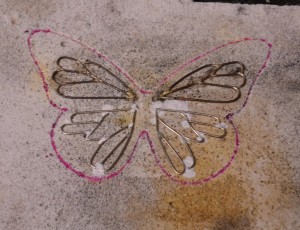
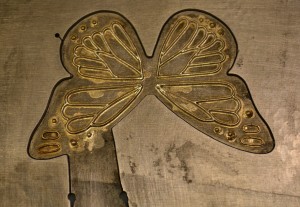
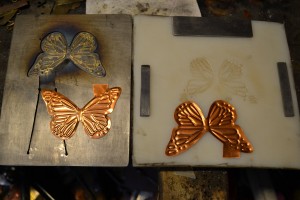

{ 1 comment… read it below or add one }
You are the man, Dar!!!! Great work as always. We’ve been able to punch every die you’ve done for us at around 2 tons. I think we can use a lower pressure because we use annealed copper flashing, where I think the samples you send have some hardness to them. (That, or our pressure gauge is off!) Anyway, working on some more designs for you… just cut ones. You need a break!